This is topic Kiva in forum Member forum at The New Huntmastersbbs!.
To visit this topic, use this URL:
https://www.huntmastersbbs.com/cgi-bin/cgi-ubb/ultimatebb.cgi?ubb=get_topic;f=6;t=004218
Posted by DAA (Member # 11) on April 29, 2015, 12:33 PM:
From a long walk I took over the weekend.
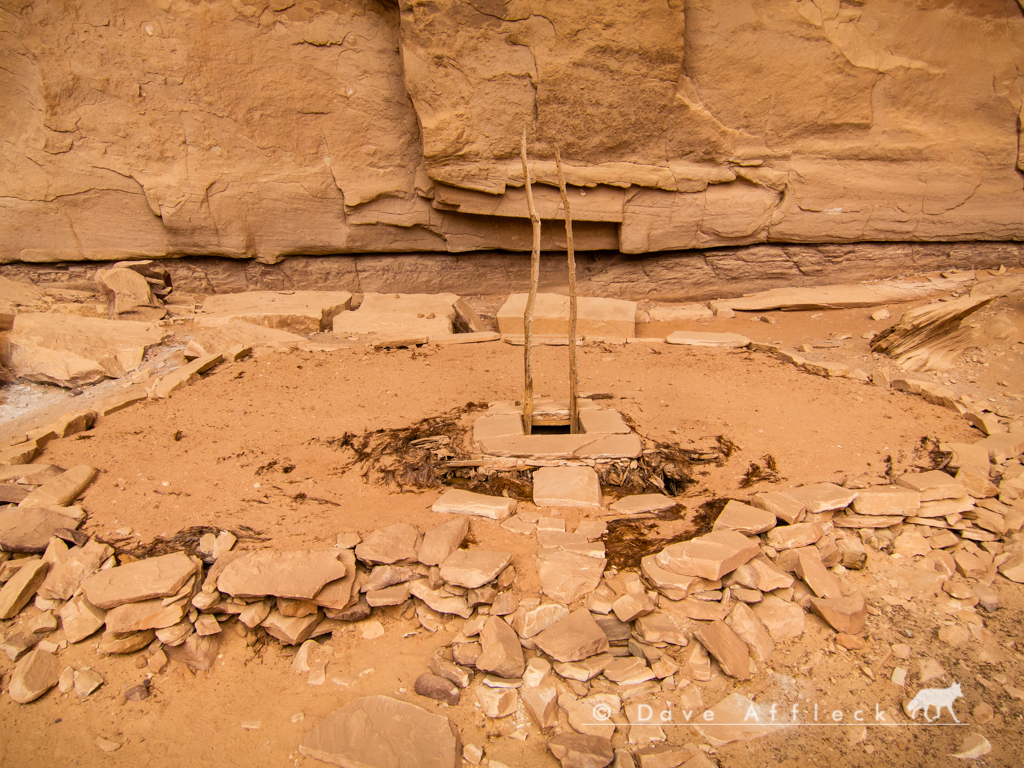
What is it, you may ask?
It's an Anasazi kiva. But it's the least messed with, most intact, "wild" kiva I've ever come across. By "wild", I mean that it has not been excavated. Neither archaeologists nor looters have put a shovel to it. No federal agency has claimed it. It's just out there, waiting for people like me to stumble across it. While I know others have found it before me, there were no visible boot tracks anywhere near it on this visit and boot tracks last a long, long time in these protected alcoves.
It's at least 700 years old.
To find one this unspoiled, with the ladder still intact and everything, is just beyond rare. It's unheard of. Made my whole weekend, that is for sure!
Few other pics from the site.
700+ year old corn. Which, the corn itself is common, see it all the time. But finding an ear still on the stalk like this is just beyond rare these days - it's truly unheard of. You KNOW you have found a rarely seen Anasazi site when you find something like this!
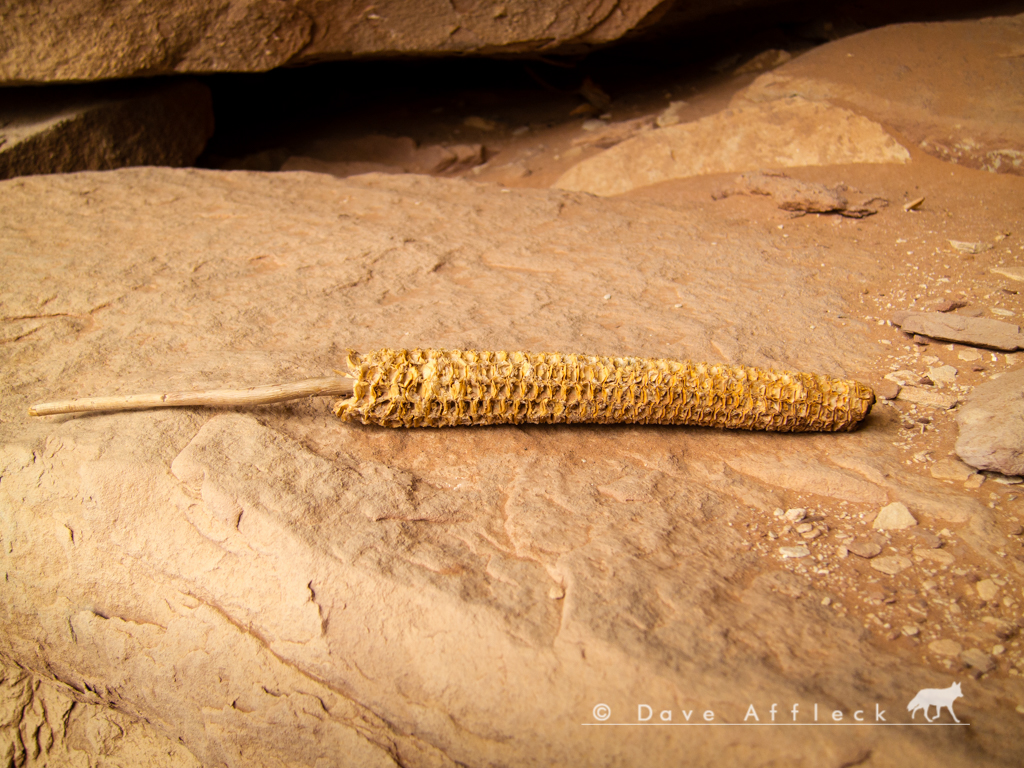
And some potsherds. Pretty garden variety, nothing unusual, but there were hundreds of them all over the whole site, which makes them unusual and obviously not messed with much. People tend to put these in their pockets. Where 20 years ago I used to see them by the thousands, it's rare to see any these days. So to find a site with hundreds of them just scattered about in this day and age sure did my heart good.
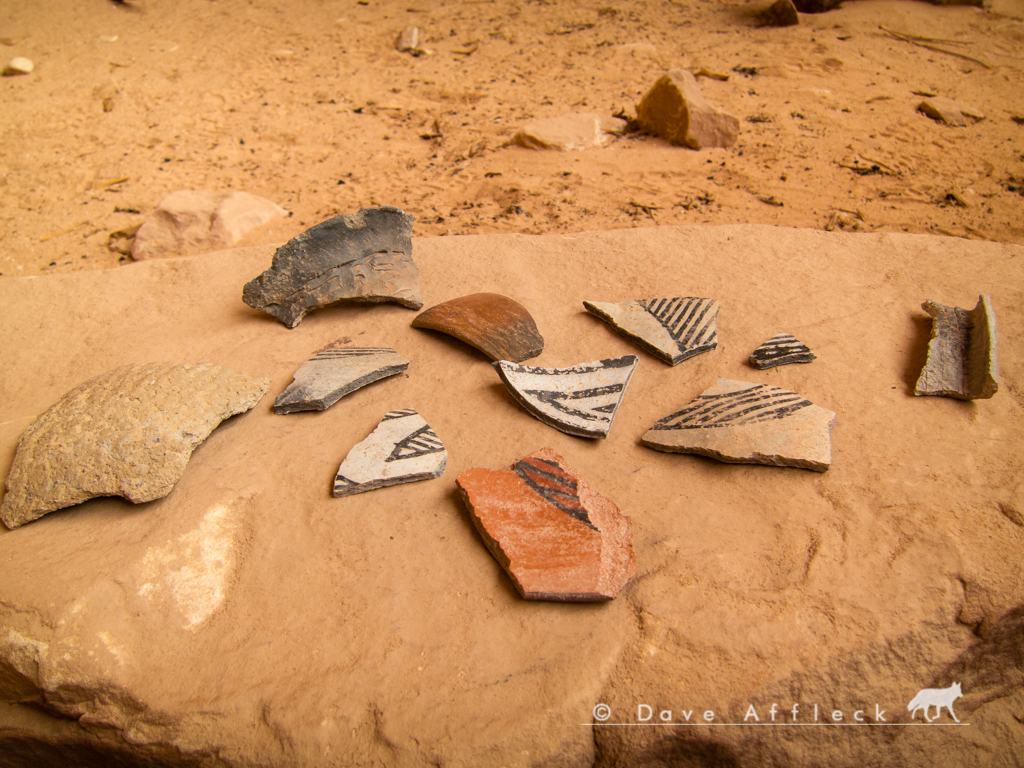
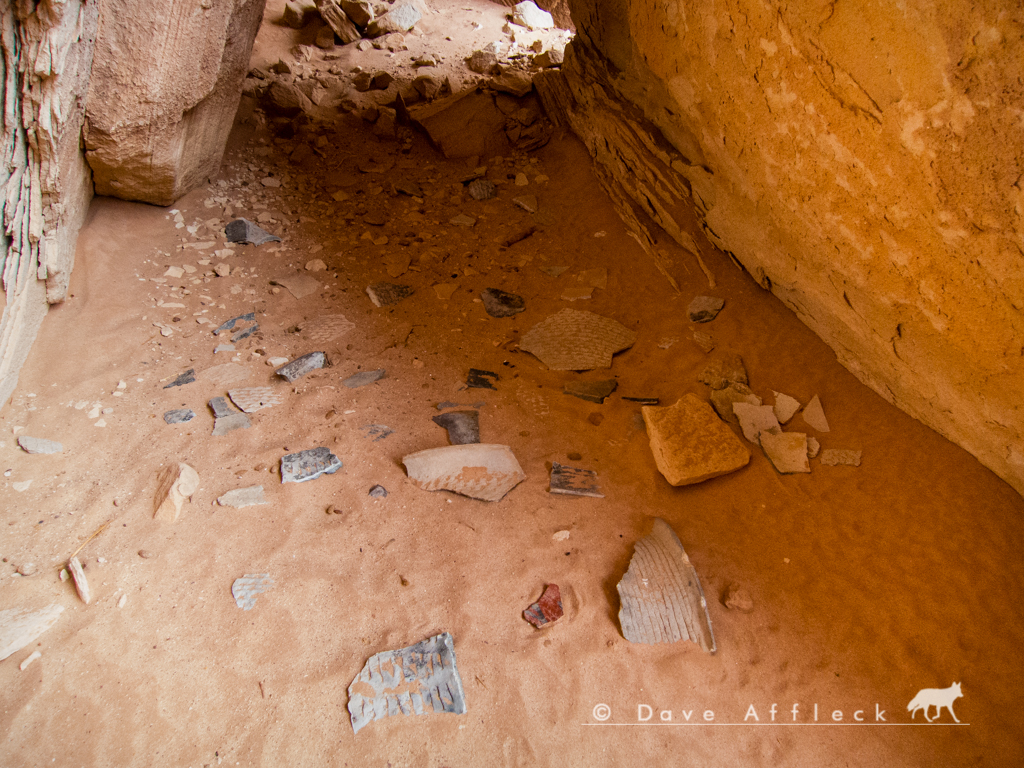
Couple more pics from the walk.
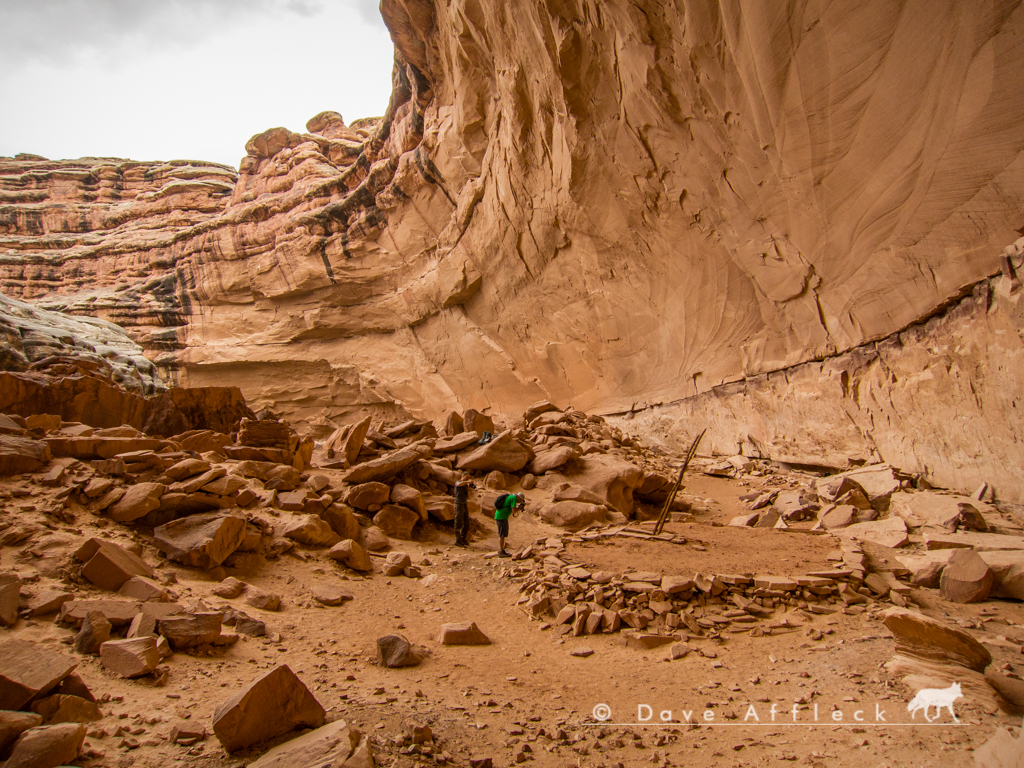
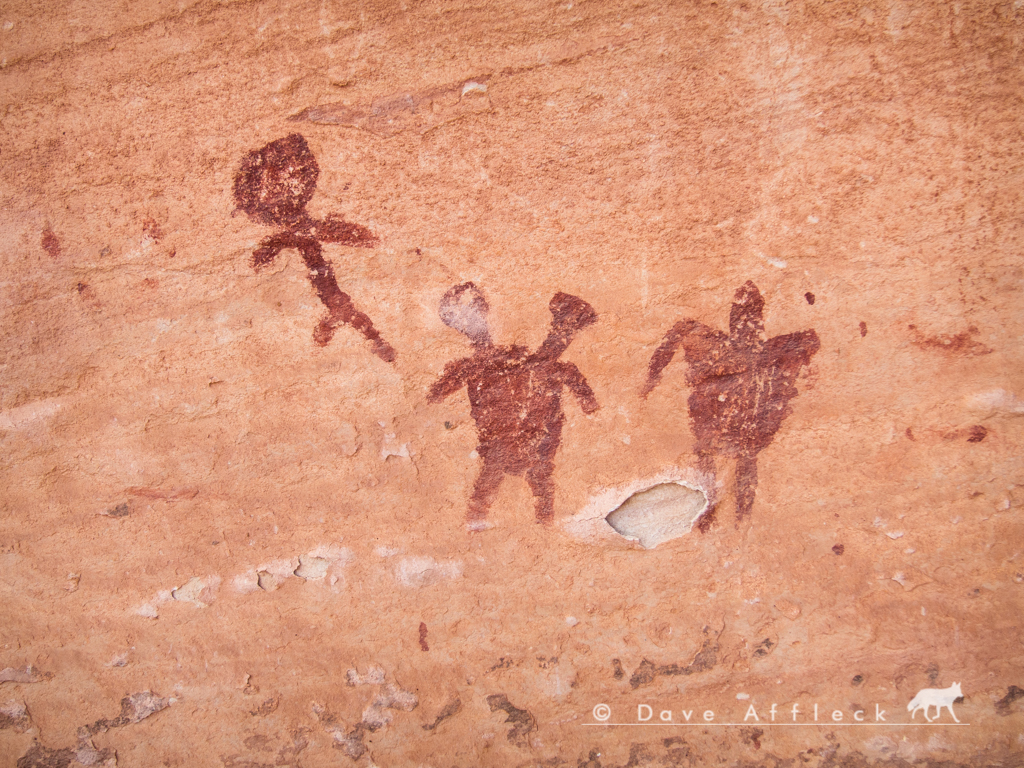
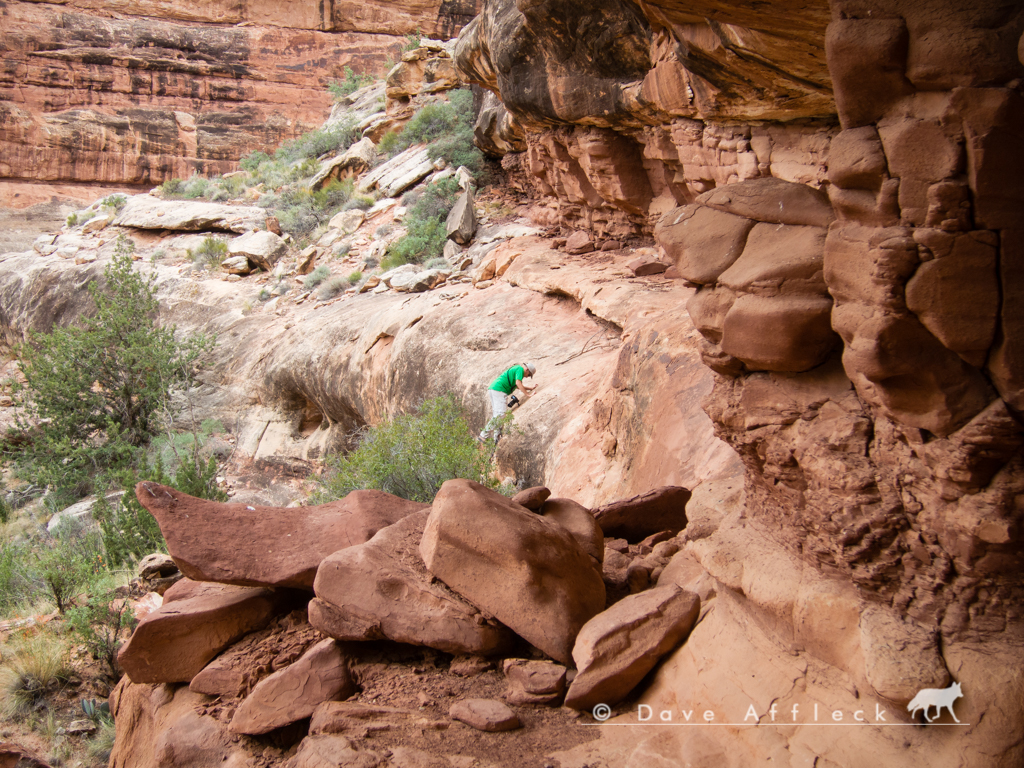
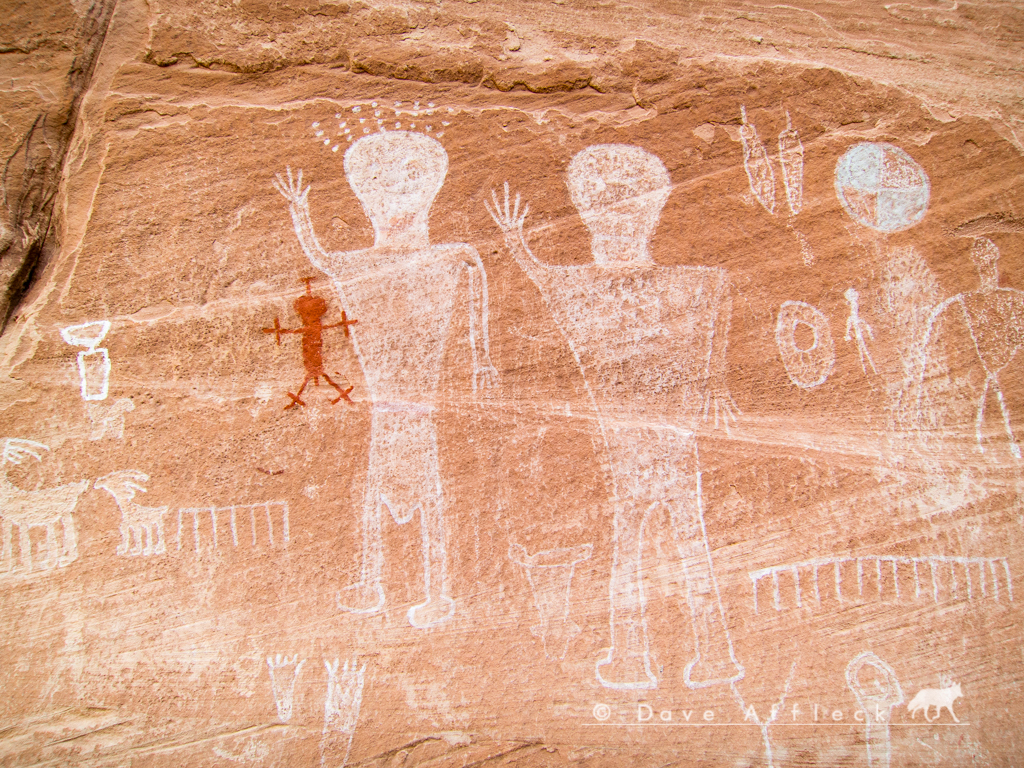
Me and two buddies walked 50 miles over the course of 3.5 days through and area about as far from civilization as you can get anymore. We saw not another human being the whole 50 miles of walking. And it was a busy weekend in the canyons, as such things go. We just picked a pretty out of the way, seldom walked area. Seldom walked because water is an iffy proposition. But, we lucked out and found plenty.
Good times!
- DAA
Posted by Leonard (Member # 2) on April 29, 2015, 01:43 PM:
Damn Dave! That's just awesome! Like something out of a Hillerman novel. But, you made a post a couple days ago claiming you could hardly walk, much less run.
The kiva. Was it underground and covered? Was that square the entrance? Did you go in there? I assume that's what the ladder was for, but not sure.
I said it before, amigo. I envy you!
Good hunting. El Bee
Posted by Kokopelli (Member # 633) on April 29, 2015, 01:56 PM:
Too cool !!!!!
![[Cool]](cool.gif)
Posted by DAA (Member # 11) on April 29, 2015, 02:08 PM:
Leonard, yes, underground and covered. Square entrance, via ladder.
I didn't try going in. A 700+ year old ladder with rungs tied on with yucca fiber is a little too adventurous for me. Not to mention, the site has been undisturbed for so long, who am I to wreck that? Leave it undisturbed, is my approach.
Also saw what I would bet was a burial in the alcove. I didn't step on it or mess with it at all. I could even be wrong, might have been a simple storage cyst, but I don't think I am...
- DAA
Posted by Leonard (Member # 2) on April 29, 2015, 04:00 PM:
So how did you come up with 700? Online research or what?
Did you at least shine an LED down the hatch?
DAMN MAN ! Your adventures are literally awesome!
Good hunting LB
Posted by Lonny (Member # 19) on April 29, 2015, 04:20 PM:
Wow, that is beyond cool Dave...
Anybody who has an interest in ancient people dream of finding something like you did.
Thanks for posting the pics and I'm glad it was somebody like you that understands and appreciates this sort of stuff otherwise I can imagine it would be ruined in short order.
I would have bet a crisp $100 bill that nothing like this was left to be found in such an undisturbed condition anymore.
Posted by DAA (Member # 11) on April 29, 2015, 05:27 PM:
Leonard, at least 700 years because there is universal agreement among southwest archaeologists that the Anasazi abandonment of the Colorado Plateau was complete by 1300 A.D.
So, any Anasazi stuff in the area has to be at least 700 years old. A lot of it, is much older. Some of it much, much older. But this style of kiva is what they call Pueblo 3 style, which was only the last couple hundred years before abandonment. So, pretty safe to say this ruin is between 700 and 900 years old.
I've got a stack of books and published studies and thesis about this stuff. The Old Ones has long been a favored subject, been studying them since before there was an internet. Not just the Anasazi, either, though they do get most of the ink and a lot of my attention. But the Fremont, who ranged over the Great Basin and the cultures that came before them, simply known as "archaic", too.
And let's not forget the settlers either! Cattleman, cowboys, miners, Mormon's, I've always had an interest in all the history of the American West. Here are the remains of an old cowboy camp we encountered on this hike.
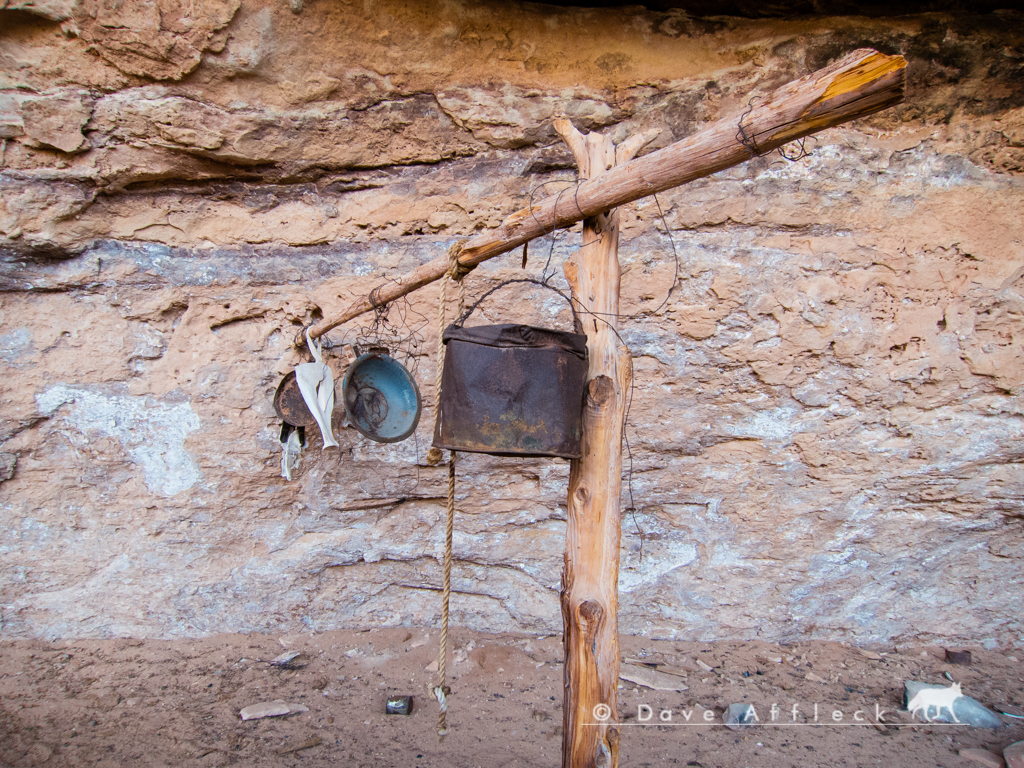
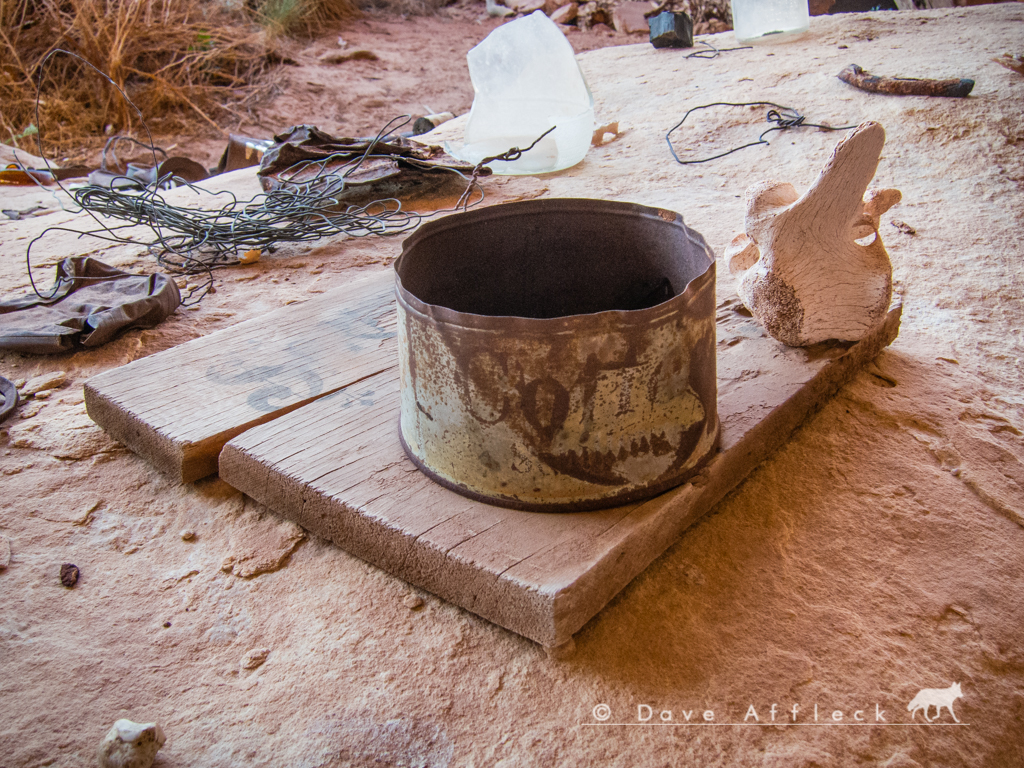
Been awhile since I've seen even a partially intact barrel still sitting where it was left however long ago.
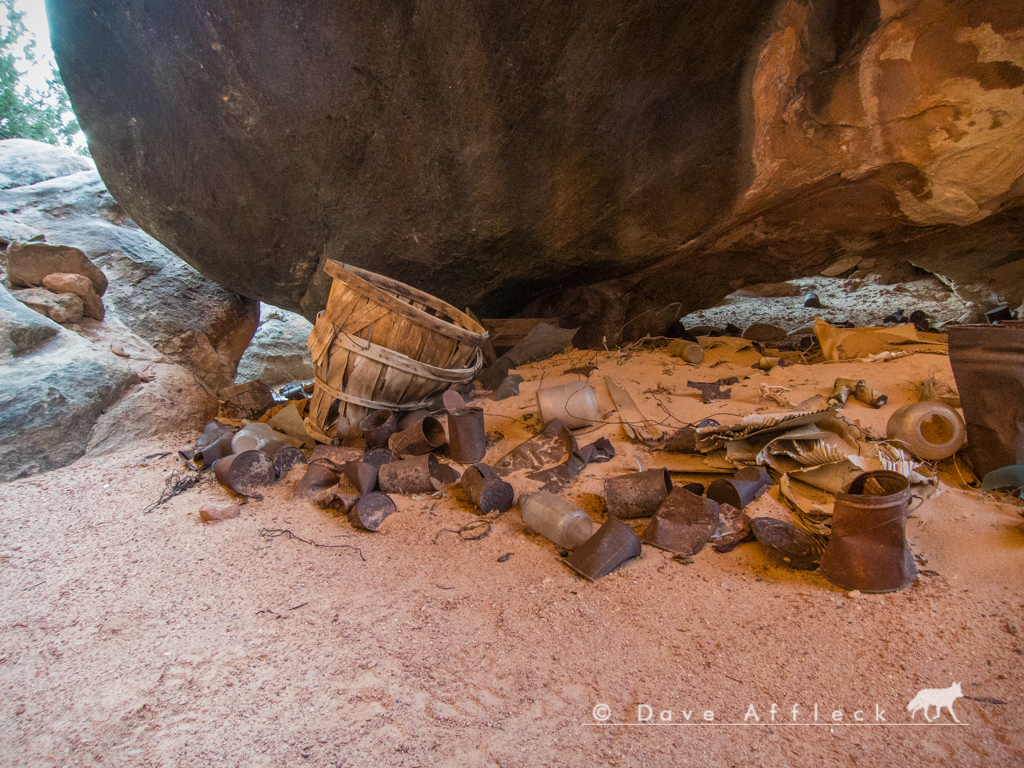
- DAA
Posted by DAA (Member # 11) on April 29, 2015, 05:31 PM:
Lonny, you wouldn't believe what one of my buddies on this trip found last month. He found a completely whole, intact Anasazi pot. Just sitting in the dirt where it was put down 700+ years ago.
He didn't even touch it. Took some pictures and left it where he found it. He'd tell me where it is, if I asked, but I didn't ask. I know which canyon he was in, hoping I can find it on my own.
We know another guy, that found a whole, intact basked in the same canyon we were hiking this past weekend. He found it almost 20 years ago. Went back and looked again 2 years ago and says it is still sitting there exactly as he'd last seen it. We had our eyes peeled, on this trip, hoping, but that's one I suspect we'll never find on our own.
Oh, and Leonard, no did not even shine a light in. I didn't want to risk even putting my weight on that roof. Not for my safety, but for the risk of damaging the ruin. It might support an elephant, I don't know. But wasn't willing to take the chance.
- DAA
Posted by DAA (Member # 11) on April 29, 2015, 05:32 PM:
Neat camp spot we had under an arch on Fri. night.
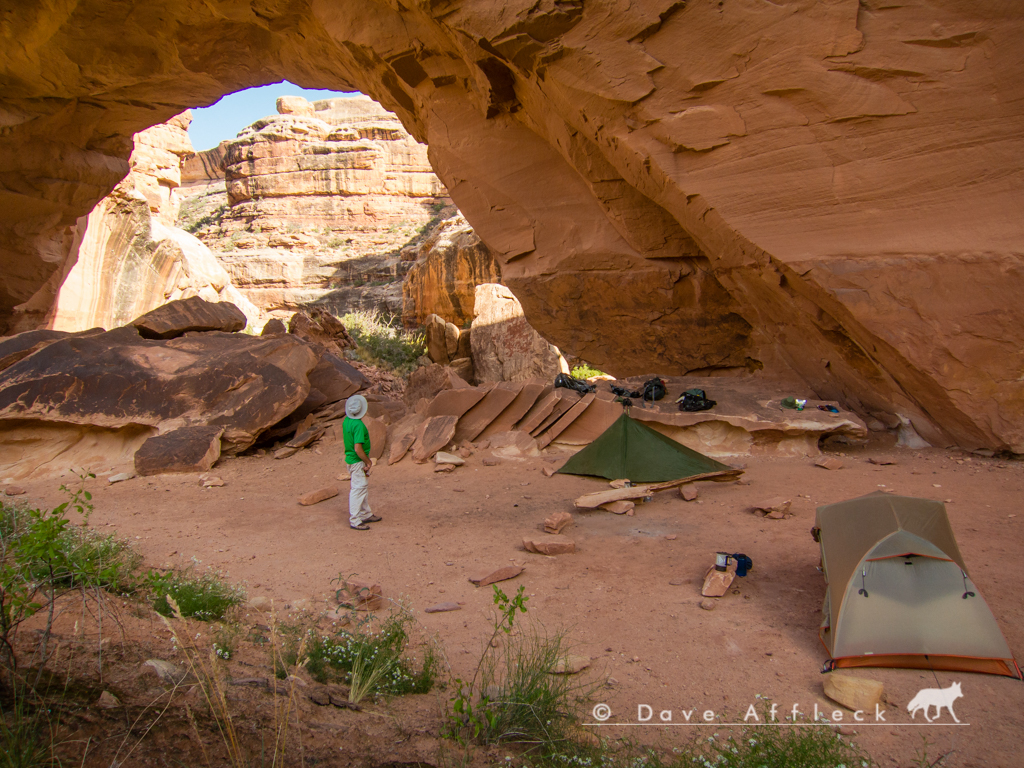
- DAA
Posted by TOM64 (Member # 561) on April 29, 2015, 05:55 PM:
That is just too cool!
I have a buddy fixing to be shipped off to either Utah or Nevada to start drilling a new oilfield. I showed him pics from your last post and told him I was coming to visit, love the country.
Posted by Lonny (Member # 19) on April 29, 2015, 06:44 PM:
Dave,
From your studying of the Anasazi, how different was the area they lived in then compared to now.
Posted by Clint (Member # 346) on April 29, 2015, 06:58 PM:
Probably a few less Mormons and better hunting, They left for some reason.
Posted by Leonard (Member # 2) on April 29, 2015, 07:16 PM:
I' ve seen a few ruins, Montezuma's Castle and the Anistazi ruins close to San Franscisco Peak and a few others which you can drive to so that's embarassing compared to your efforts.
And, that cowboy camp is also just as thrilling, if you ask me?
You know, one of my prized findings, a virtually perfect mortar and matching pestle, you have me feeling guilty for "disturbing" it!
Good hunting. El Bee
Posted by knockemdown (Member # 3588) on April 30, 2015, 03:15 AM:
RESPECT
Friggin' phenomenal finds, Dave!
Thanks so much for sharing them...
Posted by DAA (Member # 11) on April 30, 2015, 04:21 AM:
Lonny, the area was quite different, towards the end of their era, than it is now.
But, as a culture, they inhabited the area for at least a couple thousand years and the climate and resources, the way they used the environment, it all changed a lot over time. So, to answer that question, you kind of have to pin it down to a specific period in the Anasazi culture. Which, is more or less defined as starting around 750 AD and lasting up till the abandonment at 1300. Prior to that, the same people had a different lifestyle, called the Basketmaker culture. Before that, they call them archaic. But Basketmaker is basically when they started growing corn and Anasazi is when they started building pueblo style structures.
Anyway... By the end, there had been a decades long drought, the mesa tops were deforested, there was almost no big game left to hunt, things were grim!
It's probably not much less dry today. What was a drought for that time, is closer to normal for the current.
But the dense PJ forest in that particular area now, has all grown up since the Anasazi left. They'd pretty much denuded the area for fire wood.
The big game populations, deer especially, are much higher today. Big horn, hard to say. Their numbers are pretty low, due to domestic sheep diseases, but they were also low then, due to hunting. Might be sixes? But earlier in the Anasazi history, big horn were much more plentiful in the area than today.
There has been massive amounts of erosion in that area since the Anasazi left. Massive! Credit that to the cattle that grazed the canyon for many years. Cattle trails become arroyo cutting, which leads to landscape changing erosion on a huge scale.
But, in a lot of ways, it's not changed. Those rocks take time to change. The fact that so many of the ruins are so well preserved speaks to that.
- DAA
Posted by DAA (Member # 11) on April 30, 2015, 04:24 AM:
Another big difference, at the height of their occupation, the area was far more densely populated than it is today.
That is true for many areas in the west. Hard to imagine now, but it's estimated that indeed, there were perhaps ten times as many people living in San Juan county Utah 900 years ago, than there are today!
- DAA
Posted by booger (Member # 3602) on April 30, 2015, 05:02 AM:
That is way beyond cool...thanks for sharing, Dave!
Posted by TRnCO (Member # 690) on April 30, 2015, 05:02 AM:
cool stuff Dave. Thanks for sharing some of your pics.
Posted by Leonard (Member # 2) on April 30, 2015, 05:39 AM:
This friggin' guy is awesome in several different ways!
Just consider his coyote calendars. Then there is his videos, coyotes, prairie dogs etc. and, he has more custom rifles than even Fred and kelly, put together. He seems to know back country backpacking like few others, speaks with authority on ancient cultures. How about the pioneer expeditions, places few of us have ever seen. And, an expert coyote hunter, true "rifleman".
He's a fund of knowlege. We are lucky to have him, I'm impressed! Can you tell?
Good Hunting. El Bee
Posted by Eddie (Member # 4324) on April 30, 2015, 06:40 AM:
Dave very nice pictures...Did the Anasazi have a road system that connected the different Pueblos together like the Incas or Astecs?
Posted by DAA (Member # 11) on April 30, 2015, 07:02 AM:
Eddie, they did have a road system. Exactly what purpose it served, is still largely a mystery though.
Basically, all roads radiated out from Chaco canyon. Towards the other "great houses" of the Anasazi domain - places like Mesa Verde, Aztec, Kayenta, etc. And they all went absolutely straight, even though the terrain might have dictated they should have some curves! They were much wider than could have possibly been needed for people on foot, too. Some of them were (are?) a couple hundred miles long.
If you know what you are looking at, remnants are not hard to see even today.
The roads don't seem to make "practical" sense. Several very interesting theories about those roads. Mostly involving ceremonial, or religious or "pilgrimage" use. The most interesting theories about all this stuff, are put forth by an archaeologist named Lekson. He wrote a book about 20 years ago called the Chaco Meridian. Made some very unconventional claims. Most of it was absolutely trashed by his peers, when he first put it all forth. Now, 20 years later, much of it has either been largely proven by actual data, or at least has come to be accepted as the general consensus by his peers.
One of his controversial theories, that has since become widely accepted, is that kivas were the basic living quarters - NOT the "ceremonial chamber" as had been universally thought up until recent years. But now, most southwest archaeologists agree, the kiva was where the Anasazi lived.
But those roads! Lekson has his theories, which are fascinating, but impossible to be certain of any of it yet at this point.
- DAA
Posted by Leonard (Member # 2) on April 30, 2015, 07:05 AM:
Let's see what he says, but my hunch is, no. I don't think the society was that advanced, culturally and politically to have something like civil servants, ie:road crews. These people were "hunter-gatherers" with ties to outlying camps but i really can't envision a need or the wherewithal for actual roads other than game trails. The Incas and mayans were a lot more advanced and wealthy. These indians were primitive in comparason. The Incas could build a wall with huge boulders, but you couldn't
Slip a piece of paper between the cracks. The anastazis basically just stacked flagstone or possibly used adobe on some pueblos, but the craftsmanship was not comparable. And, I think the need to travel from site to site wasn't nearly as commercial as it was, (perhaps) social?
Good hunting. El Bee
Posted by DAA (Member # 11) on April 30, 2015, 07:08 AM:
Some interesting work has been done that shows the Anasazi had a long range communications network too. Using high points and line of sight. It's been shown they were capable of routinely transferring messages over hundreds of miles in only a few minutes time.
Some remote, high altitude pueblos seemed to have served little other purpose than astronomical observation and communications relay. They're built in locations where simple resources like water and arable land for food production are too far away - these pueblos had to be "supplied" to exist.
All of it indicates a pretty advanced and well regulated civil society and power structure.
Some of the most compelling theories concerning the abandonment have more to do with revolt and the people turning their backs on that top down power structure, in favor of a more egalitarian society. Rather than simply an environmental and resources collapse.
- DAA
Posted by Leonard (Member # 2) on April 30, 2015, 07:08 AM:
Well, so much for my half baked theories!
Posted by Leonard (Member # 2) on April 30, 2015, 07:16 AM:
But, i think it is beyond dispute that, (as mentioned by Dave) that they ran out of wood for fires. For cooking and for warmth.
This alone can make you want to pack up and seek better conditions. LB
edit: this iphone crap is for the birds!
Edit: I'm not buying this speculation about disfavtisfaction with the power structure being responsible for the collapse. They left no written records other than drawing on rocks, so it cannot be reliable to read the tea leaves to come up with specific reasons. For my money Alex, i'll take resource depletion fot $1000. LB
oh, and GLOBAL WARMING on the daily double !
[ April 30, 2015, 07:26 AM: Message edited by: Leonard ]
Posted by DAA (Member # 11) on April 30, 2015, 08:32 AM:
Could be. Not likely anyone is ever going to have any certainty.
It's pretty difficult to explain a complete - absolute 100% depopulation of such a large area, that had been lived in constantly for thousands of years, simply because of resource depletion though.
Modeling predicts there were still enough resources for the whole population, even if on short rations and modified behavior.
But take away half, two thirds of the population, the remaining resources were more than sufficient for the remaining population.
The abandonment was not a single, en masse event. It took place over several decades as people started to leave the area in small groups. Then towards the very end, those that remained, seemingly did, all at once, just walk away. Not pack up and leave. They left an awful lot of their material goods behind. But just up and left all the sudden.
Nobody stayed though. Nobody! Really nothing stopping the stragglers from staying where their fathers and fathers, fathers had lived. By the late 1200's, the few remaining had not only plentiful natural resources left for the greatly reduced population, but all the material goods that had been left behind by the ones who had already left. They could have just sat tight and been fat cats. But they left too.
Resource depletion and environmental stress played a large role, I'd bet on that. But I personally think there had to have been more to it. A generation watching the priests exact tribute, but fail to deliver on their rain promises would have generated some dissention. I think there was some major, major societal upheaval going on. The cliff dwellings - those are all very late game structures. It's not how they had lived for hundreds of years before that. Very defensive structures. Evidence all points to mass killings and people eating each other when there was other food to be had and the like. Some evidence that the priests had been eating people all along.
Shit got very strange on the Colorado Plateau in the late 1200's.
- DAA
[ April 30, 2015, 08:34 AM: Message edited by: DAA ]
Posted by Leonard (Member # 2) on April 30, 2015, 08:44 AM:
Well, i'm ok with tribal warfare as a possible motivation for the virtual abandonment. At what point did the Navajo start moving in and I have heard they were not good neighbors....still aren't.
Very interesting subject.
Good hunting. El Bee
Posted by DAA (Member # 11) on April 30, 2015, 10:32 AM:
Depends who you ask, as to when the Navajo showed up. They say they have always been there. Archaeologists and Anthropologists all say not until about 300 years after the Anasazi left.
- DAA
Posted by knockemdown (Member # 3588) on April 30, 2015, 11:16 AM:
Dave, without trying to get caught up in the "ancient aliens" hooplah, may I ask if any of the resources you've referenced to educate yourself on Anasazi culture happened to mention any 'extraterrestrial' hypotheses about their demise?
Posted by DAA (Member # 11) on April 30, 2015, 11:22 AM:
Nope, not a one! No alien theories espoused in any of the books or papers I've read.
And, the mystery is why they all left. Not where they went. We know where they went. They didn't disappear. They assimilated with other pueblo tribes to the south, mostly along the Rio Grande.
Still there is mystery there though. And it goes back to the thoughts about real social upheaval and rejection of the system.
They took none of their material culture with them. They made magnificent pottery. They stopped making it when they left. They had distinctive architecture. They stopped building that way when they left. And so on.
But, DNA is conclusive - it's no mystery "where" they went. No disappearance. Just an abandonment and relocation.
- DAA
Posted by ursus21 (Member # 3556) on April 30, 2015, 11:50 AM:
This is flat out one of the coolest, if not the coolest, post I've seen on the net in a very long time! Thanks Dave!!!
Posted by Leonard (Member # 2) on April 30, 2015, 03:42 PM:
About cannibalism. This is a very touchy subject among the various tribes, to the point that they deny historical evidence. I suppose it mostly involved eating enemies, maybe ceremonial, spiritual? But, there is archeological evidence, human bones with butchering marks, stuff like that. If you can believe the movies, maybe they ate the heart of a brave warrior to gain some advantage. If the priests or shamans did it, fine but it's pretty clear it happened, some times, some places. I think they have analyzed fossilized Coprolites and found human DNA. The denial, is right up there with the contention that they have been there since the Great Spirit created the people from dust or some other substance. So, there is a lot of deferment to whatever the elders have passed down for generations. And, it's all good, they were noble people, not savages.
Good hunting. El Bee
[ April 30, 2015, 04:51 PM: Message edited by: Leonard ]
Posted by Eddie (Member # 4324) on April 30, 2015, 10:10 PM:
To leave because of tribal warfare or resource depletion, you would think that they would have held on to there customs and beliefs.
I think Dave is right about something strange going on. Might have been a split between the ruling class and the lower class. But to make a clean brake from ones culture like they did is amazing.
Posted by Lonny (Member # 19) on May 01, 2015, 06:35 AM:
Best thread I've read anywhere in a long time.
Thanks Dave for sharing your pictures and knowledge on this subject.
Posted by Cdog911 (Member # 7) on May 01, 2015, 12:27 PM:
Dave, I got to the pic where you first show the pottery shards and before I scrolled down, I wondered to myself if you would have gotten any of the classic Anasazi-only pottery, and you did.
You said, " They made magnificent pottery..."
In that pic, you guys can see shards where there is a black line embedded in the clay, sandwiched between the outer and inner white layers. I have an uncle and aunt who live about six miles NE of Mesa Verde. You can see the backside of Mesa Verde from their front yard and they own land, called Dawson's Canyon, that empties into Yellowknife Canyon just above the area beneath the villages and dwellings at Mesa Verde. They have the foundations of partially subterranean dwellings that have been dated to 3,000 prior to the Anisazis on their ground, and their neighbor has a kiva on his ground as well. Very little pottery left there because of everyone collecting it (they no longer allow it to be removed), but we did find a shard with the black inner layer and my uncle told me that this was considered an incredibly valuable find because of the history of that particular type of pottery. The clay is not molded that way. Rather, the layering happens due to the specific way the pottery is fired. Modern efforts to reproduce that technique failed for well over a hundred years, up to about ten years ago when I saw an article that the University of Colorado had published that someone had actually discovered (again) how to fire their pottery so it came out the same way.
That picture rocketed me back to a place, a time, and a conversation with one of my favorite uncles. Thanks!
Posted by Kokopelli (Member # 633) on May 04, 2015, 04:18 PM:
Interesting;
In one of the washes that I've hunted that type of shard is pretty common.
My own personal theory on the abandonment is that it had to be religious in nature. As in a living God turned out to be `ignore the man behind the curtain` type thing for an entire people to walk away from their land, goods and culture.
Posted by DAA (Member # 11) on May 04, 2015, 04:55 PM:
The fashionable theory 20 years ago was the "kachina phenomena". New religion, to the south, kachina.
Not a very popular explanation anymore though. Has had some pretty big holes blown in it.
But abandoning the religion they had been practicing for centuries, not necessarily to go embrace anything else in particular, I think that is very likely a big part of it.
- DAA
Posted by Az-Hunter (Member # 17) on May 04, 2015, 05:04 PM:
I have a place 20 minutes from my place here, that we have found some extraordinary pieces of pottery, bone tools and spear/arrow points. I have one particular piece of pottery, that when held just right to the light source, the painted pattern sparkles, under a glass, it looks as though ground up pieces of mica were blended with the paint?
Took the wife and two of her friends, who wanted to see if they could find an arrow head. I walked them up a narrow, five foot deep wash, where I occasionally have found some good ones. The one gal, was from Quebec, spoke very little english, and was dragging up the rear. I usually have the eye for points, and was looking hard, when this gal spoke up, wondering if she had something good.
I wanted to grab it and stuff it in my pocket! It was absolutely the finest example of a point I have ever laid eyes on, and she had no clue what it was. This point was maybe three inches long and inch and a half wide, very thin, and crystal clear, with rusty/orange spider web of viens running all thru it. When held to the sunlight, it was like looking at stained glass.
Ive walked that wash a hundred times and never found any that nice....beginners luck I suppose?
Posted by Leonard (Member # 2) on May 04, 2015, 07:35 PM:
That's interesting, Vic. I remember a while back, you showed me a small collection of turquoise beads and teeth that you culled from ant hills.
But, like I said before, a point the size you describe is not an arrow head. The aerodynamics would guarantee that such an arrow would not arrive point on-too heavy. Probably some type of projectile point as would be used on a spear, atlatl or lance. Still very cool!
Good hunting. El Bee
edit: by the way, I know a guy in Texas that has more paleo amerind artifacts than you could imagine. A full shipping container, I would love to ride with him one afternoon, he has an unbelievable site somewhere?
[ May 04, 2015, 07:38 PM: Message edited by: Leonard ]
Posted by Colorado Coyotes (Member # 62) on May 30, 2015, 10:53 AM:
I almost missed this thread, I mostly just read a few things and move on.
Absolutely amazing stuff. Having talked to Dave privately about some things I figured him to be an interesting fella. I had no clue.
Thanks for posting this info Dave. Someday maybe we'll get a chance to shake hands.
Posted by Colorado Coyotes (Member # 62) on May 30, 2015, 10:59 AM:
I almost missed this thread, I mostly just read a few things and move on.
Absolutely amazing stuff. Having talked to Dave privately about some things I figured him to be an interesting fella. I had no clue. I've seen his photographic skills and read about his firearm/ballistic knowledge but this special.
I used to hang out with a friend years ago who had a degree in anthropology (I think) but never talked about it, too busy drinking beer & chasing girls.
Thanks for posting this info Dave. Someday maybe we'll get a chance to shake hands.
Sorry double post.
[ May 30, 2015, 11:02 AM: Message edited by: Colorado Coyotes ]

UBB.classicTM
6.3.0








![[Cool]](cool.gif)



